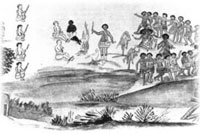Small Planet Communications, Inc. + 300 Brickstone Square, Andover, MA 01810 + (978) 794-2201 + Contact







The Carolina Grant began as one entity. Geographical and political differences among its English settlers would eventually cause a split, however.
North Carolinians were small tobacco farmers, not plantation builders. South Carolinians developed a low-country agricultural system that relied upon slave labor to grow and export rice, cotton, and indigo.
Small farmers and frontiersmen grew angry at the political and economic power held by coastal planters. These tensions would ignite during the American Revolution, turning the Carolinas into a fierce battle between north and south, east and west.
View a map of American
Indian territories
in South Carolina.
Then click any of the
tribe names to learn
about that group of
American Indians.
Long before the arrival of the first European settlers, many American Indian groups lived in the region now known as the Carolinas. Three major language families were represented in the American Indian population: Iroquoian, Siouan, and Algonquian. Early inhabitants included the Cherokee, Catawba, Creek, and Tuscarora, among many others.
The earliest European exploration of present-day South Carolina took place around 1514 by Spanish explorers. Italian explorer Giovanni da Verrazano explored the coastal region of present-day North Carolina in 1524. Although Spanish explorers made several attempts at colonizing both areas over the next few decades, no permanent settlements were established until 1670.
Coastal North Carolina was the site of the first English attempts to colonize the New World. Two colonies began in the 1580s under a charter granted by Queen Elizabeth to Sir Walter Raleigh. Both were at Roanoke Island, and both failed. In another early colonization effort, a group of French Huguenots started a short-lived settlement on Parris Island in 1562.
In the 1650s, the first permanent English settlers in North Carolina actually came from the southern part of the Virginia Colony and settled in the Albemarle area in the northern part of present-day North Carolina. Thirteen years later, Charles II granted a charter to eight Englishmen who would serve as Lords Proprietors of the Carolina Grant. In honor of King Charles I, the name Carolina was given to the colony—the Latin word for Charles is Carolus.
In 1669, the proprietors attempted to implement a rigid social structure. The plan was outlined in The Fundamental Constitutions of Carolina, which was written by the political philosopher John Locke, secretary to Sir Anthony Ashley Cooper, one of the eight proprietors.
According to the Fundamental Constitutions, the Carolina Grant was divided into square counties. In every county, each of the eight proprietors owned 12,000 acres. Other ranks of nobility were assigned tracts of land no smaller than 3,000 acres. Labor on each manor was done by "Leet" men and women, over whom their owners were guaranteed absolute power and authority, and who were bought and sold as part of the property of the manor.
More than a few colonists questioned the practicality of the system laid out by the Fundamental Constitutions, however. While a city might be laid out in squares, a country shaped by rivers, creeks, hills, swamps, and mountains was not so easily demarcated. The colonists felt that the mere abundance of land meant that development would be free and open, not subject to strict regulation. Although the Fundamental Constitutions remained technically in effect for several decades, the document had little to do with the actual development of the Carolinas.
DID YOU KNOW?
North Carolina has 1,500 lakes
of 10 acres or more in size and
37,000 miles of fresh water
streams. Click to learn more
facts and trivia about North
Carolina and South Carolina.
Geography also shaped the Carolina culture. The vastly different environments of the northern and southern parts of the Carolina grant dictated that settlements would develop in significantly different ways. The harbor and natural coastline of southern Carolina allowed easier trade with the West Indies. The result was the development of an urban, cultured, and cosmopolitan society made up of wealthy planters and merchants.
In the north, many settlers were small farmers who drifted down from Virginia and planted tobacco, as they had done at home. Centered on Albemarle Sound, northern Carolina was poor, but independent. The population was diversified with the arrival of thousands of emigrants from Scotland, Ireland, and Germany. Their practice of farming was not heavily dependent upon slave labor in the southern region.
DID YOU KNOW?
Eliza Lucas Pinckney a teenager at the
time, helped make indigo a profitable
crop in South Carolina by conducting
experiments in her back yard.
In the southern part of the grant, the proprietors and early settlers from Barbados founded Charleston in 1680 on the coast where the Ashley and Cooper rivers flowed into the Atlantic. The planters learned how to grow rice, a lucrative export crop. The easily-flooded lowlands along the rivers were ideally suited to its cultivation. Cotton, a staple crop used in manufacturing textiles, found favorable conditions on the sandy sea islands that fringed the coast. Indigo, a plant that produced a coveted blue dye, was later added to the list of Carolina products that were sold profitably abroad.
All of South Carolina's crops lent themselves to being worked by large groups of laborers, and by 1720 more than half of the people in South Carolina were enslaved workers.
Large plantation and slave owners dominated South Carolina society. Because the low country that produced their wealth was so rampant with disease, however, the planters took to keeping town houses in Charleston. They spent at least the summer months in the city, when malaria was at its peak. In the meantime, the enslaved workers labored in the midst of heat, humidity, and swarms of mosquitoes.
Pirates posed another problem for Carolina. The colony's unusual coast, with its sandbars and shallows, provided a haven for pirate ships. Furthermore, the colonists frequently benefited from purchasing the pirates' goods. The capture and execution of the pirate known as Blackbeard in 1718 ended the threat of piracy in the Carolinas.

Learn more about the
Tuscarora War.
Trouble with the native inhabitants started when the settlers began encroaching on their farmland and capturing and enslaving them. Between slave raids in 1670 and a strain of deadly smallpox brought over by Europeans, the American Indian population in the Carolina region declined sharply. Some groups of American Indians decided to fight back, beginning with the Tuscaroras, an Iroquoian tribe. After a long, bloody war, the Tuscaroras were defeated in 1713, with many survivors drifting north to rejoin other Iroquois tribes. In 1715, two more American Indian groups battled the colonists in South Carolina—the Yamasees and the Creek. Had the Cherokee tribe elected to ally themselves with the Yamasees and the Creek, English colonialism in South Carolina might have come to an end. The Cherokee did not participate, however, and the colony remained intact.
Find out more about
Cary's Rebellion, a
political and religious
conflict.
Meanwhile, the colonists themselves were divided by political disagreement. Edward Hyde came from England in 1711 claiming the office of governor. His right to the post was disputed by Thomas Cary, who had been named governor in 1705. In the dispute that followed, known as Cary's Rebellion, Hyde and Cary both attracted supporters who actually took up arms against each other. The conflict ended with Cary's defeat.
In 1712, recognizing the different social underpinning of the northern and southern settlements, the proprietors granted the two Carolinas separate assemblies and governors. When the proprietors sold their holdings to the king in 1729, he confirmed North Carolina and South Carolina as separate royal colonies. This boundary was not established until 1732, nor fully surveyed until 1815.
Read about North Carolina's
War of Regulation.
Explore more history of
North Carolina and South
Carolina.
Until the outbreak of the American Revolution in 1775, a more efficient government brought about increased settlement and greater prosperity. Settlement extended to the Blue Ridge Mountains and beyond. With this movement arose the deep-seated differences between east and west that continued for decades. The colonial government was dominated by the eastern planters, and the poorer west suffered from corrupt government and excessive taxes. The whole structure was conducive to abuses of power. The conflict resulted in the War of Regulation, in which the western insurgents were crushed at the Battle of Alamance Creek on May 16, 1771.
The battle-weary Carolinians fought through the French and Indian War in the 1760s and the Revolutionary War in the next decade only to become the site of the first shots fired in the Civil War on April 12, 1861. South Carolina lost one-fifth of its adult white males over the course of the Civil War. When the Union troops led by General William Tecumseh Sherman overcame the Confederates, they left a path of destruction in their wake. It took many years for the war-torn area to recover.
The Carolinas | Bibliography
- Claggett, Stephen R. "North Carolina's First Colonists: 12,000 Years Before Roanoke." 1986; revised 1996. North Carolina Archaeology. Accessed 6/18/19. http://www.archaeology.ncdcr.gov/ncarch/articles/1stcolo.htm
- Explore Charleston. "An Overview of the Charleston Area." Accessed 6/18/19. https://www.charlestoncvb.com/media/media-kit/historic-overview/
- Lane, Ralph. "The Colony at Roanoke." 1586. National Center for Public Policy Research. Accessed 6/18/19. http://www.nationalcenter.org/ColonyofRoanoke.html
- Library of Congress. "North Carolina." Accessed 6/18/19. http://www.americaslibrary.gov/es/nc/es_nc_subj.html
- Library of Congress. "South Carolina." Accessed 6/18/19. http://www.americaslibrary.gov/es/sc/es_sc_subj.html
- NCpedia. "Colonial period (1600-1763)." Accessed 6/18/19. http://ncpedia.org/category/subjects/colonial-period
- North Carolina Department of the Secretary of State. "North Carolina History." Accessed 6/18/19. https://www.sosnc.gov/divisions/publications/kids_page_history
- Powell, William S. "Regulator Movement." 2006. NCpedia. Accessed 6/18/19. http://ncpedia.org/history/colonial/regulator-movement
- Price, William S. "Cary Rebellion." 2006. NCpedia. Accessed 6/18/19. https://www.ncpedia.org/cary-rebellion
- SandersWeb.net. "Some Interesting Facts About North Carolina." Accessed 6/18/19. http://www.sandersweb.net/nc/ncfacts.htm
- South Carolina Cotton Board. "South Carolina Cotton Statistics." Accessed 6/18/19. http://www.sccotton.com/education.htm
- South Carolina State Library. "South Carolina History: Introduction to South Carolina." Accessed 6/18/19. https://guides.statelibrary.sc.gov/sc-information
- South Carolina's Information Highway. "SC Indians–Native Americans in South Carolina." Accessed 6/18/19. http://www.sciway.net/hist/indians/
- ThingsToDo.com. "North Carolina State History." Accessed 6/18/19. http://www.thingstodo.com/states/NC/history.htm
- Troxler, George W. "Battle of Alamance." 2006. NCpedia. Accessed 6/18/19. http://ncpedia.org/alamance-battle
- World Web Technologies Inc. "Charleston Travel Guide." Accessed 6/18/19. http://www.charleston.worldweb.com/
- Yale University, Avalon Project. "The Fundamental Constitutions of Carolina: 1669." Accessed 6/18/19. http://avalon.law.yale.edu/17th_century/nc05.asp
The Carolinas | Image Credits
- Carolinas and Virginia, 1663–1729 | Adams, James T., Ed. Atlas of American History. New York: Charles Scribner's Sons, 1943. (p. 24)
- John Locke | Artist: John Greenhill, c. 1672–1676; National Portrait Gallery, London
- Indigo Plant | Photo by Thomas G. Barnes, 2004; Natural Resources Conservation Service
- Tuscarora | Artist: Cristoph van Graffenreid; The North Carolina Office of Archives and History, University of North Carolina Press, 2003.
© 2020 Small Planet Communications, Inc. + Terms/Conditions + 300 Brickstone Square, Andover, MA 01810 + (978) 794-2201 + Contact


